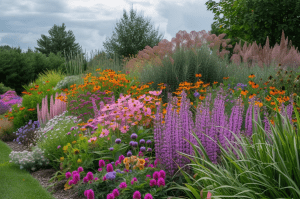
With a dash of greenery and a sprinkle of care, you can enjoy your very own herbal haven. Picture this: you’re cooking a delicious meal, and instead of reaching into your spice rack, you stroll out to pluck fresh rosemary from your garden. Sounds enticing? This article, “Creating Your Own Slot Online Gacor Herbal Garden: A Step-by-Step Tutorial,” transforms this fantasy into reality.
Even if you’ve never so much as planted a seed before, you have no need to worry. We break down the process into manageable steps, to ensure your green-fingered journey is a success. Say farewell to bland dishes and expensive herb packets as you immerse yourself in the fulfilling and health-boosting world of homegrown herbs. Whether it’s on a window sill, in your backyard, or even in the tiniest urban balcony, look forward to sowing the seeds of your very own herbal nirvana, one plant at a time. Your taste buds, and indeed your wallet, will thank you!
Benefits of Having Your Own Herbal Garden
The benefits of having your own herbal garden are multi-faceted. Not only can it enhance your culinary prowess by providing fresh, organic herbs at your fingertips, but it can also offer a therapeutic hobby that’s both rewarding and sustainable. Gardening can be a great stress-reliever, providing a peaceful sanctuary amidst the hustle and bustle of daily life.
What’s more, homegrown herbs are renowned for their superior flavor, aroma, and nutritional value compared to store-bought varieties. They are free from harmful pesticides and chemicals, and they are always at their peak freshness. This can lead to healthier meals and a more adventurous palate, as you have the freedom to experiment with different herbs in your cooking.
Additionally, having your own herbal garden can help you save money. Herbs can be quite expensive to buy regularly, but they are surprisingly cheap and easy to grow. Plus, many herbs are perennial, meaning they grow back year after year with minimal effort, providing a consistent supply of fresh herbs for your kitchen.
Understanding Different Types of Herbs
Before you start planting, a basic understanding of different types of herbs can be very beneficial. Broadly speaking, there are three types of herbs: culinary, medicinal, and ornamental.
Culinary herbs like basil, rosemary, and thyme are used to enhance the flavor of your dishes. These herbs are usually aromatic and have strong flavors. Medicinal herbs such as lavender, chamomile, and mint have healing properties and can be used to make teas, oils, and other remedies. Ornamental herbs like lavender and chives can add beauty to your garden with their vibrant colors and interesting textures.
Along with these types, you also need to consider if the herbs are annual, biennial, or perennial. Annual herbs (e.g., basil, dill) complete their life cycle in one season and need to be replanted each year. Biennial herbs (e.g., parsley, caraway) live for two years, producing leaves in the first year and flowers and seeds in the second. Perennial herbs (e.g., rosemary, mint) live for several years and can provide a continuous supply of herbs.
Steps to Create Your Herbal Garden
Creating your own herbal garden may seem daunting, but by following a few simple steps, you can have a thriving garden that provides fresh herbs all year round.
The first step is to choose your location. Most herbs require at least six hours of sunlight each day, so choose a spot that gets plenty of sun. Herbs also need good drainage – they don’t like to sit in water. If you’re planting in containers, make sure they have drainage holes.
Next, prepare your soil. Herbs prefer well-drained, slightly acidic soil. You can improve your soil’s drainage by adding organic matter such as compost or well-rotted manure. If you’re growing herbs in pots, a good quality potting mix will provide the right conditions for your herbs.
Once you’ve prepared your soil, you can start planting your herbs. You can either start herbs from seeds or buy young plants from a nursery. If you’re starting from seeds, follow the planting instructions on the seed packet. If you’re planting young plants, dig a hole twice as wide and as deep as the root ball, place the plant in the hole, and fill it in with soil.
Essential Tools for Herbal Gardening
Having the right tools can make your gardening journey much easier and more enjoyable. Some essential tools for herbal gardening include a trowel for digging and planting, a garden fork for turning and aerating soil, a watering can or hose with a gentle spray for watering, and pruners for trimming and harvesting herbs.
You may also need a hoe for weeding and breaking up soil, and a garden rake for smoothing soil and removing debris. If you’re gardening in containers, you’ll need pots or containers with drainage holes, and a good quality potting mix.
Other useful tools include garden gloves to protect your hands, a garden kneeler to make gardening more comfortable, and a garden cart or basket for carrying tools and harvested herbs. Remember to clean your tools after each use to keep them in good condition.

Best Practices in Caring for Your Herbal Garden
Caring for your herbal garden involves regular watering, feeding, pruning, and pest management. Most herbs prefer soil that is slightly moist but not waterlogged. Water your herbs when the top inch of soil is dry. Overwatering can cause root rot, which can kill your plants.
Feeding your herbs with a balanced organic fertilizer can help them grow strong and healthy. However, avoid over-fertilizing as this can cause your herbs to grow too quickly, resulting in less flavorful leaves.
Regular pruning can encourage your herbs to bush out and produce more leaves. It can also prevent your herbs from bolting (producing flowers and seeds), which can decrease the quality of the leaves. But remember, different herbs have different pruning needs, so it’s important to research each herb’s specific requirements.
Common Challenges in Herbal Gardening and How to Overcome Them
Like any gardening venture, growing herbs can have its challenges. Common issues include pests, diseases, and weather conditions.
Pests like aphids, slugs, and snails can damage your herbs. You can control these pests by encouraging beneficial insects, using barriers and traps, or applying organic pesticides. Diseases can be prevented by practicing good garden hygiene, such as rotating crops and cleaning tools regularly.
Weather conditions can also affect your herbs. Most herbs are tolerant of a range of conditions, but extreme heat, cold, or wind can cause damage. Protect your herbs from extreme weather by providing shade or protection, and ensure they have adequate water in hot conditions.
Harvesting and Using Your Herbs
Harvesting your herbs is one of the most satisfying aspects of herbal gardening. The best time to harvest herbs is in the morning, after the dew has evaporated but before the sun gets too hot. This is when the oils that give herbs their flavor and aroma are at their peak.
To harvest herbs, simply cut off the stems with a sharp pair of pruners. Be sure not to cut more than one-third of the plant at one time, to allow it to continue growing. After harvesting, you can use your herbs fresh, or you can dry or freeze them for later use.
Using your herbs in cooking can transform your dishes. Try adding fresh basil to a tomato sauce, rosemary to roasted potatoes, or mint to a refreshing drink. Experiment with different combinations to find your favorites!
Expanding Your Herbal Garden
Once you’ve mastered the basics of herbal gardening, you might want to consider expanding your garden. You can do this by adding more varieties of herbs, or by creating themed herb gardens, such as a pizza garden with basil, oregano, and thyme, or a tea garden with mint, chamomile, and lemon balm.
You can also expand your herbal knowledge by learning more about the medicinal properties of herbs, and how to make your own herbal remedies. Or you can explore the world of ornamental herbs, and use them to create beautiful garden designs.
Whatever direction you choose to take, remember that herbal gardening is a journey, not a destination. Enjoy the process, learn from your mistakes, and celebrate your successes!
Conclusion
Creating your own herbal garden is a rewarding endeavor that can enhance your cooking, improve your health, and bring joy to your life. By understanding different types of herbs, following simple steps to create your garden, using the right tools, and practicing good garden care, you can enjoy a thriving herbal garden.




